February 20, 2015
Air Date: February 20, 2015
FULL SHOW
SEGMENTS

FBI Questions Keystone XL Activists
View the page for this story
In October 2014, the FBI began contacting at least a dozen people who had been involved in protests against fracking and tar sands oil development, including the Keystone XL pipeline.. Host Steve Curwood speaks with reporter Becky Kramer and attorney Larry Hildes about the FBI’s investigation and the history of surveillance against political activists. (10:30)

Harvard Sued Over Fossil Fuel Investments
View the page for this story
Harvard students and faculty have been calling for the University to rid its endowment portfolio of fossil fuel investments, to little avail. Now in a novel case, Harvard students have sued their institution in a bid to force divestment. Plaintiff and Harvard Law student Kelsey Skaggs tells host Steve Curwood about the suit and the importance of fighting climate change for future generations. (05:40)

Plastics and Male Reproduction
View the page for this story
A new study in the Journal of Human Reproduction finds that a common chemical used to create flexibility in plastics can affect baby boys’ development in the womb. Lead researcher Dr. Shanna Swan talks with host Steve Curwood about the affect that phthalates have on the developing fetus and the threat they may pose to male reproductive health later in life. (06:15)
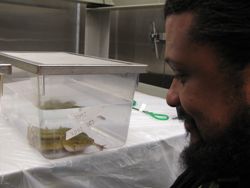
Hormone Disruptors Linked to Genital Changes and Sexual Preference
/ Ashley AhearnView the page for this story
Scientists continue to sound the alarm about some common chemicals, including the herbicide atrazine, and link them to changes in reproductive health and development. Endocrine disrupting chemicals have been found to feminize male frogs and increase the incidence of homosexual behavior among those amphibians. Ashley Ahearn reports on how these substances may be affecting human development and behavior. (05:07)

Beyond the Headlines
/ Peter DykstraView the page for this story
In this week’s trip beyond the headlines, Peter Dykstra tells host Steve Curwood about a proposed Superfund site, the need to update the Toxic Substances Control Act, and Pluto’s prospects for reinstatement to full planet status. (04:10)
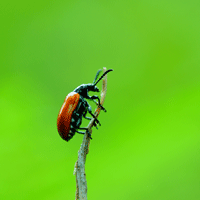
Evolution in the Age of Mass Extinction
View the page for this story
From climate change to habitat destruction, humans are causing species to die out at alarming rates all around the world. But as biologist Chris Thomas tells host Steve Curwood, the pressure on ecosystems today is also leading to a surge in adaptation and evolutionary diversity. (11:35)
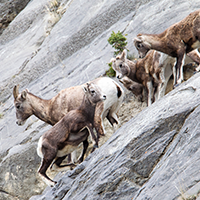
Learning to Climb
/ Mark Seth LenderView the page for this story
By late summer, the lambs of Rocky Mountain Bighorn sheep have grown, equipped with feet that can grip on sheer cliff faces, but as writer Mark Seth Lender observed in Alberta’s Jasper National Park, this may not be enough--a ewe can lead her lambs to the edge, but it is they who have to negotiate the way down, alone. (03:00)
Show Credits and Funders
Show Transcript
HOST: Steve Curwood
GUESTS: Becky Kramer, Larry Hildes, Kelsey Skaggs, Shanna Swan
REPORTERS: Ashley Ahearn, Peter Dykstra, Mark Seth Lender
[THEME]
CURWOOD: From Public Radio International, this is Living on Earth.
[THEME]
CURWOOD: I'm Steve Curwood. Harvard law students are suing the university, demanding it dump fossil fuel investments for the sake of themselves and future generations.
SKAGGS: An action of divestment now would send a message that Harvard is not willing to be part of this system in which fossil fuel companies are given impunity to destroy the planet and destroy the future of Harvard students.
CURWOOD: Also, more evidence that hormone-disrupting phthalates can inhibit proper development of baby boys - and the chemicals are hard to avoid.
SWAN: A number of studies have actually measured phthalates in foods. They've been found in milk, they've been found in sauces, they've been found in meats, they've been found in spices, believe it or not. The problem is that we don't really know because there's no labeling.
CURWOOD: That and more this week on Living on Earth. Stick around.
[NEWSBREAK MUSIC: Boards Of Canada “Zoetrope” from “In A Beautiful Place Out In The Country” (Warp Records 2000)]
ANNOUNCER: Support for Living on Earth comes from United Technologies – innovating to make the world a better, more sustainable, place to live.
FBI Questions Keystone XL Activists

Helen Yost of Moscow, Idaho received a text message in October from someone who identified himself as an FBI agent, asking to speak with her. Yost co-founded Wild Idaho Rising Tide, a climate action group. In July 2013 Rising Tide’s Portland chapter hung a banner that read “Coal, oil, gas, none shall pass” from the Interstate Bridge over the Columbia River. (Photo: Adam Elliot/Portland Rising Tide; Flickr CC BY-NC-SA 2.0)
CURWOOD: From the Jennifer and Ted Stanley Studios in Boston and PRI, this is Living on Earth. I’m Steve Curwood. Ever since the Keystone XL pipeline to bring Canadian tar sands oil to Gulf coast refineries was first proposed in 2008, it’s faced strong opposition, including acts of civil disobedience. During recent months some activists have received visits from FBI agents keen to ask them questions.
Becky Kramer, a staff reporter with The Spokesman-Review, based in Spokane, Washington was among the first to publish this story back in January, and joins me now from her office in western Idaho. Welcome to Living on Earth.
KRAMER: Thank you.
CURWOOD: Now your article on January 23 opens with a description of an Idaho woman who is receiving a text message from an FBI agent. What happened?
KRAMER: This woman, Helen Yost, lives in Moscow, Idaho, and she's a cofounder of a group called Wild Idaho Rising Tide. The group has been involved in protests against oversized oilfield equipment moving through the region, through the northwest, to Alberta's tar sands, and she received a text message from an FBI agent in December saying that he needed to speak with her and asked her to give him a call.
CURWOOD: So what did she say happened next?
KRAMER: She said that on the advice of her attorney, she declined to talk to the agent.
CURWOOD: Now, what has she done and what has her organization done in terms of activism? I understand at times they've been arrested?
KRAMER: Some people were arrested for being on the road when the oil equipment was moving through. Helen was not arrested for being in the road; she was fined $243 for disturbing the peace after she threw a protest sign at the back of a mega load shipment that was moving through.
CURWOOD: Talk to me about the other person who was contacted by the FBI. What was the story you heard from that person?
KRAMER: Well, I also spoke with Herb Goodwin. He's a 65-year-old activist from Bellingham, Washington, and he said that he was contacted by the FBI in October. He said a city police officer and a woman who identified herself as an FBI agent came to his door. They asked him if he would answer questions about a group called Deep Green Resistance and he said he declined.
CURWOOD: And Herb Goodwin was also involved with these protests?
KRAMER: Yes, he came over to protest the mega loads moving through Idaho and he has also been involved in protests against coal trains in his hometown of Bellingham.
CURWOOD: When you spoke with the activists for the purpose of writing a story, or perhaps later on when you got comments, what, if any of them said that they felt a chilling effect on their activism by these inquiries from the FBI?

The FBI has contacted at least a dozen environmental activists since October, but claims no criminal investigation is underway. (Photo: Cliff; Flickr CC BY 2.0)
KRAMER: Well when I talked with Herb Goodwin, and he said, and I'll quote him directly, "It's actually pretty spooky to have the FBI show up at your door, ask one question and leave”. And he said “I think they were there to put me on notice that I was being watched."
That’s journalist Becky Kramer of Spokane’s The Statesman-Review. Well, after his inquiry from the FBI, Herb Goodwin sought legal advice from Larry Hildes, an attorney in Bellingham, Washington, who’s well known for his work with civil disobedience cases. And soon after he began working with Herb Goodwin, Mr. Hildes says that other environmental activists began to contact him with similar stories.
HILDES: Herb put out our contact information to Deep Green Resistance and to some other groups and the calls started to flood in, and this was early October of 2014. We got calls from a dozen people over the course of October, November, some of whom had multiple contacts by the FBI. All over Washington, Oregon, Idaho, northern California, Nevada, a couple from Colorado and apparently as far east as Pennsylvania. That continued through December and into early January when the first media started to come out bringing this to public light, and that as far as we know is when the FBI harassment stopped.
CURWOOD: I understand that some of the people who called you, at least one of them, had the FBI show up at their place of work. Can you tell me that story please?
HILDES: Sure. A woman who lives outside of Portland had two visits at her workplace from the FBI. They both were timed for exactly when her boss was out and she was alone in the office. And the first time they refused to leave until she set a time and place to talk to them. She was afraid if her boss came back and saw this she would lose her job, so she gave them a time and place and then canceled. So they came back and sat down and said we're not leaving until you talk to us and answer all our questions, and at that point she gave them my name and number, and they said to her, "We don't want to talk to your lawyer. Your lawyer doesn't have the information we want. You do." So she invoked her right to counsel, and they made clear they weren't going to follow the Constitution. That they were going talk to her anyway, and she was afraid at that point for her job and for her safety and so she talked to them for a while.
CURWOOD: What kind of information were they looking for?
HILDES: They wanted information on her environmental activities and other political activities. They asked about people, some of them she knew, some of whom she didn't know, and they told her that she was not a suspect; this was not a criminal investigation. But each time they've insisted there is no criminal investigation, your client is not a subject of a criminal investigation, we're just trying to gather information for our own education. That's funny because the FBI in their public statements and their policies insist that they only do criminal investigations. If they call someone, it's because that person is either a witness or subject of a criminal investigation. So the question is kind of when are they telling the truth and when aren't they.
CURWOOD: Now, in the Pacific Northwest in the past there have been some violent incidents, some SUVs were burned at a dealership in Portland and other activities that people sometimes term eco-terrorism. To what extent to think the FBI is looking into something like that?
HILDES: Well, first of all none of the folks that they have talked to or tried to talk to have any history of violence. None of them have advocated violence, none of them have engaged in or advocated property destruction. And they caught the people who did those acts, and those people went to prison. And none of these folks have anything to do with those folks, and if you look at what the FBI has done in general against the left and in specific against the environmental movement since the 80's, most of their contacts, their harassment, their actions, have been against people who were not engaged in any violence or property distraction.

The Earth Liberation Front has never been a centralized group; instead, individual “cells” with only a handful of members plan and carry out ecological sabotage, or “ecotage.” (Photo: VJ Beauchamp; Flickr CC BY-NC-SA 2.0)
CURWOOD: So what's the motivation of the FBI in looking into the environmental activists there in the Pacific Northwest?
HILDES: They keep telling me there's no criminal investigation, so if they're not investigating crime, they're not investigating potential crime, the only thing that's left to conclude is that they're trying to intimidate and silence these movements. We're at a point where the environmental movement is heating up, the movement to stop climate change is gaining a lot of momentum and historically those are the points where the FBI has intervened and disrupted movements, intimidated people. The Keystone XL controversy is coming to a fore right now. If for some reason President Obama were not to veto the pipeline, people have said all over the country that they're going to engage in civil disobedience and demonstrations, not property destruction, not violence, but peaceful protest, and I can only conclude from what's going on that this is an attempt to silence folks before that happens. Almost all of the folks who have been contacted are involved in some way with protests against the Keystone XL pipeline and the tar sands and movements related to those.
CURWOOD: Now, the FBI famously wiretapped Martin Luther King, and it was involved in extensive surveillance in the civil rights movement, also the anti-Vietnam war movement, but they apologized for that. They asked for forgiveness and said that that was in the past.
HILDES: There's no reason to think that it ever stopped. When I was in college in the early-to-mid 80s, the FBI got caught spying on and harassing the Committee in Solidarity with the People of El Salvador (CISPES) which never committed anything remotely involving violence or property destruction, but peacefully advocated for change in Latin America and change in US policy towards dictatorships in Latin America, and they did all the same stuff. They harassed, they showed up at people's doors, they tapped people's phones, and again they apologized, they said it would not happen again, and it has continued through every director of the FBI since then, and this is a point where those movements are stepping up and the FBI's historical response to dissent on the left and to activities is to try and stop it by intimidation and by force.
CURWOOD: Larry Hildes is an attorney in Bellingham, Washington. Thank you so much, Larry, for taking time with us today.
HILDES: Thank you, Steve.
CURWOOD: We contacted the FBI, and a spokeswoman replied and I quote, “The FBI’s media policy prohibits discussing ongoing investigations—or even the existence or absence of an investigation—except under rare circumstances.” She also wrote that “the FBI takes care to distinguish between constitutionally protected activities and illegal activities undertaken to further an ideological agenda.” The full statement is on our website, LOE.org.
-----------------------------------------------------------------
Email exchange of Living on Earth producer Naomi Arenberg wth Ayn Sandalo Dietrich-Williams, Media Coordinator, FBI Seattle Division February 12, 2015
Our query:
1. In light of several reports on FBI agents visiting so-called "environmental activists" in Idaho, Washington, and Oregon, is there anything in general you could say about those visits?
2. What information is the Bureau seeking from these individuals?
3. Is the Bureau monitoring activities related to the tar sands? If so, then why?
4. Is the Bureau conducting an investigation into apparent tar sands related events, especially those of civil disobedience?
5. Do you know of environmental activists outside of Washington, Oregon, and Idaho who have been contacted by the FBI?
6. Has the Bureau received any information from those who've been contacted? If so, then what?
--
Naomi Arenberg
Living on Earth
Response:
The FBI has a very restrictive media policy, so I apologize that my answers will not provide the details you’re hoping to receive. I’m copying my counterparts in the Portland and Salt Lake City offices, as they handle inquiries related to Oregon and Idaho, respectively. I’m confident my comments also apply to their areas, though.
In response to your first question, I can only point out that on any given day, FBI employees are outsomewhere conducting routine activities. These could be activities related to community outreach, emergency response, or investigations. Our contacting a person does not mean that the person is the subject of an investigation.
I also want to be clear that the FBI takes care to distinguish between Constitutionally protected activities and illegal activities undertaken to further an ideological agenda. The FBI has the authority to conduct an investigation when it has reasonable grounds to believe that an individual has engaged in criminal activity or is planning to do so. This authority is based on the illegal activity, not on the individual’s political views, position, or any other beliefs.
This information speaks to your questions #2, 5, and 7. Regarding questions #3 and 4, the FBI’s media policy prohibits discussing ongoing investigations—or even the existence or absence of an investigation—except under rare circumstances.
I hope even this general information can be helpful in some way.
Regards,
Ayn
Follow up Query :
I do have one further question. All of us at Living on Earth are concerned about so-called "eco terrorism" and are aware of the car burning incidents that took place in Oregon a few years ago. Is it possible for you to tell us whether the Bureau is looking into the possibility of further terrorist acts?
I appreciate your time and effort.
Regards,
Naomi
Response:
Thanks, Naomi, for your concern and thoughtful communication. I truly appreciate your view of wanting to ensure people express their opinions in a safe and constructive way.
Unfortunately, I can’t share publicly, information about any threats or criminal planning that we investigate. The FBI’s media policy prohibits discussing ongoing investigations—or even the existence or absence of an investigation—except under rare circumstances. All I can do is reassure you that when we receive credible threat reporting, we always coordinate with appropriate partners, whether those be in government or the private sector. So if an entity or person were being threatened, we’d reach out to ensure they are aware of the situation and can take precautions to protect themselves.
Ayn
Related links:
- Spokane Spokesman-Review Article : “FBI contact unwarranted, environmental activists say”
- Pacific Standard article: “Whatever Happened to ‘Eco-Terrorism’?”
- About Wild Idaho Rising Tide
-
[MUSIC: Gottschalk: The Dying Poet. Smithsonian Folkways, 1992]
Coming up...the evidence piles up of the disruptive effects of hormone mimicking chemicals. Stay tuned to Living on Earth.
[CUTAWAY MUSIC: Alberto Messirca, Farewell to Stromness. British Guitar Music, Paladino 2012]
Harvard Sued Over Fossil Fuel Investments
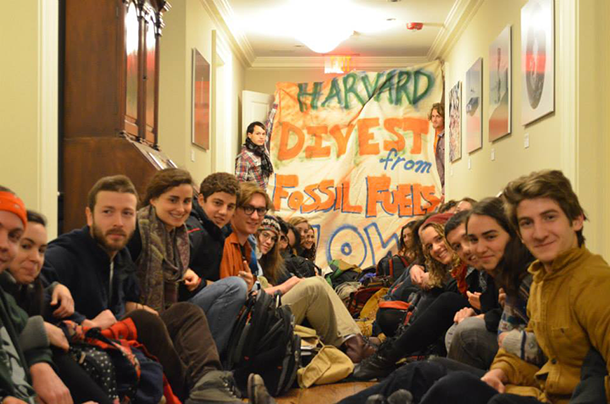
Divest Harvard sit-in. (Photo: 350.org; Flickr CC BY-NC-SA 2.0)
CURWOOD: It’s Living on Earth. I’m Steve Curwood. The idea of getting rid of fossil fuel investments in college endowments has caught a powerful wave of imagination among students, but it hasn’t caught on much among university leaders. Few colleges have actually divested, but students at the university with the world’s biggest endowment, Harvard, are vocal and active and now they’ve created a novel frontline in this battle. Students from Harvard Law – Barack Obama’s alma mater – are taking the university to court, claiming it’s violating its mission and intentionally investing in “abnormally dangerous activities” that threaten the “future habitability of the planet”.
One of the plaintiffs is second year law student Kelsey Skaggs, who’s on the line to explain the thinking behind their suit. Welcome to Living on Earth!
SKAGGS: Thank you for having me.
CURWOOD: Why do you think it's important for Harvard to divest of its investments in fossil fuels now?
SKAGGS: From a legal standpoint, it's important for Harvard to divest because they are at this point contributing to the harms of climate change, and as we all know Harvard is an elite institution, it's an opinion leader, so an action of divestment now would send a message that Harvard is not willing to be part of this system in which fossil fuel companies are given impunity to destroy the planet and destroy the future of Harvard students.
CURWOOD: Talk to me about the plaintiffs you have in this case. You are one of the plaintiffs, and you're representing yourself. Who has joined you in this action?
SKAGGS: There are three law students who are plaintiffs: myself and two other second-year students. We also have several undergraduate students, and we also have a graduate student at the Applied Sciences and Engineering graduate school. We really are committed to doing this ourselves as students. The climate change fight is the fight of our generation because it's our futures on the line.
CURWOOD: And one of your plaintiffs is, well, you call them future generations. Can you explain that for me?
SKAGGS: Yes, so in addition to our first count where we are asserting our special interest as students, we also have a second count in which the only plaintiff is future generations. So we're essentially suing on behalf of generations to come who will undoubtedly be harmed by the climate change to which Harvard is now contributing. So we're asking the court to recognize that we can sue on their behalf.
CURWOOD: Now, one of your charges in your complaint is and I quote here, "your intentional investment in abnormally dangerous activities." Sounds like a novel argument. How novel is it, and what are the boundaries of this?
SKAGGS: Yeah, climate change really does present novel legal challenges and will therefore require some aspect of novel legal solutions. In terms of the limitations of this count it really is strictly limited to climate change harms, which I think is entirely appropriate given the special nature of those harms.
CURWOOD: Tell me about the other charge you brought here.
SKAGGS: The other account is based in mismanagement of charitable funds. Some of this is based on that university's own founding documents in which it states that its purpose is to work for the advancement of the youth, and our claim as those youth is that we have special interest standing to challenge the investment decisions of the University when they're related to something as severe and irreversible as climate change.
CURWOOD: Now what are you hoping a court might order in terms of relief and response to this lawsuit?
SKAGGS: We're seeking only injunctive relief, which means that the court would order Harvard University to divest its holdings in fossil fuel companies.

Plaintiff and second-year Harvard law student, Kelsey Skaggs (Photo: courtesy of Kelsey Skaggs)
CURWOOD: How large of those holdings in your understanding?
SKAGGS: So, over the past several quarters they've fluctuated between $70 million I believe and $19 million. It certainly changes regularly and is only part of the picture.
CURWOOD: So what percentage does that represent in Harvard's endowment, that - say $70 million?
SKAGGS: It's very small; it's not a lot of Harvard's endowment, which I believe is over $30 billion at this point.
CURWOOD: What's the history of people going to court to try to get Harvard to divest in various holdings, whether it's tobacco or South Africa in the apartheid era?
SKAGGS: To our knowledge there has not been a case against Harvard calling for divestment, so in that sense were doing something new here. There have been successful divestment campaigns in the past without legal components. Famously Harvard partially divested from companies doing business in South Africa during the apartheid era. Perhaps a more apt analogy to the fossil fuel companies is when Harvard divested from big tobacco in the 1990s explicitly for public health grounds. The president of the university at that time said that he didn't want our endowment to be used for the promotion of something that causes such harm to so many people, and I think that the same reasoning can be applied to climate change except for on a much greater scale.
CURWOOD: So, what gets you up in the morning to address his case?
SKAGGS: I see this as a justice issue. Climate change exacerbates existing inequalities and the people who are most hurt by climate change are those who already are suffering under our social and economic systems. And the other reason is that I grew up in southeast Alaska, which is beautiful and wild and very special to me, and I'll do whatever I can to protect that.
CURWOOD: Kelsey Skaggs is a second-year law student at Harvard and one of the plaintiffs in the suit to compel Harvard to divest its investments in fossil fuels. Thanks for taking the time today, Kelsey. Thank you very much for having me.
SKAGGS: Thank you for having me.
Related links:
- Text of Student Complaint Against Harvard For Failing to Divest of Fossil Fuels
- Text of Harvard's Motion to Dismiss Student Suit
- Harvard Fossil Free Alumni Fund
- Plaintiffs will use Massachusetts v EPA to help argue their case
- Divest Harvard website
[MUSIC: Emperor Quartet/Johnny Greenwood, HW Hope of New Fields, Soundtrack There Will Be Blood Nonesuch 2007]
Plastics and Male Reproduction
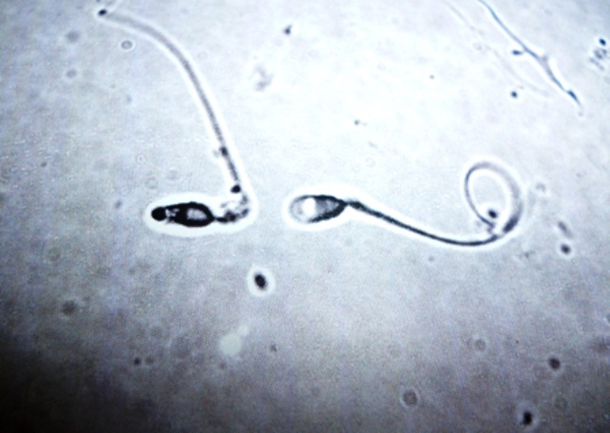
Decreased AGD is correlated with low sperm count later in life. Sperm counts have decreased by as much as 50% in Europe and the United States in the past fifty years. (Photo: Iqbal Osman; Flickr CC BY 2.0)
CURWOOD: We live in a chemical stew, with thousands of different compounds from virtually every synthetic product we use. Among the chemicals we’re exposed to daily are those that make plastics pliable – phthalates — ubiquitous in plastic products, including food containers. Phthalates are also hormone disruptors. They show up in human urine and several studies have shown they affect human development and reproduction. A new study led by Dr. Shanna Swan of Mount Sinai Hospital Medical School is the largest and most comprehensive analysis of this effect so far and Dr. Swan, is on the line to explain what they found. Welcome back to Living on Earth, Dr. Swan.
SWAN: Thank you, Steve.
CURWOOD: So, Dr. Swan, please describe in layman's terms what you studied and why that's important?
SWAN: In our study, we looked at a measure called the anogenital distance, the distance from the anus to the genitals, and this is important because it's typically about 50 to 100 percent longer in males than females and when mother is exposed to higher levels of DEHP, which is a common phthalate in foods and other products, the male distance is less masculine, more in the feminine direction so it's a mark of incomplete masculinization. It also correlates with other genital measures like penile size and testicular descent and in adults it correlates with fertility and sperm count.

The study led by Dr. Swan found that prenatal exposure to phthalates decreased anogenital distance (AGD) in newborn males. AGD is an indicator of improper male reproductive development. (Photo: Chris Martino; Flickr CC BY-NC 2.0)
CURWOOD: Dr. Swan, I believe we talked about this, what, a decade ago. What's different now?
SWAN: Well, since that time we've done a number of studies extending that initial study on AGD and phthalates. This study that’s coming out now is first of all much larger, the first one had 85 boys this has 366. This one is much more precise in the timing of exposure, the way the exposure is measured and also the outcome, how it's measured, the chemistry is much better. Very importantly, the statistical analysis is much better, we're controlling for a lot more potential confounders and that's why we could find significant associations even at this reduced exposure level, because the exposures are now 50 percent lower than when we last talked.
CURWOOD: I want to ask you a question that's not directly related to your study for a moment. What has been the trend in the sperm counts among males for the past, say, 50 years?
SWAN: That's a really tricky loaded question. We're currently doing a very large meta-analysis of 7,000 studies to try to tie that down, but there's been a decrease in sperm count about one percent per year which is pretty big over 50 years. It was steeper in Europe, less steep in the United States and we had no data in other countries, so I can't say worldwide, but they're certainly cause for concern and it's an important end point to study.

Phthalates are found in many plastics, including baby bottles. Dr. Swan says that when a moist, warm product such as milk or formula comes into contact with plastic, phthalates can leach into the liquid. (Photo: Eric Peacock; Flickr CC BY-NC-SA 2.0)
CURWOOD: Now, in your opinion as a scientist and as a medical researcher, what are the health risks that phthalates may pose to humans and which segments of the population do you think might be at greatest risk?
SWAN: Let me answer the second first. Unquestionably, it's the developing fetus that's at highest risk. This study is on reproductive end points. We have another two publications on neurodevelopmental end points related to phthalate exposure, and the jury is still out. People are working hard to identify all the ways in which phthalates can impair development, but certainly anything that's related to testosterone and might be impaired by decreased testosterone in early development will likely be altered by phthalates.
CURWOOD: So how ubiquitous are phthalates?

Milk from a dairy farm may also contain phthalates, depending on whether the processing equipment and packaging contained phthalates. (Photo: Rupert Ganzer; Flickr CC BY-NC-SA 2.0)
SWAN: Ninety-nine percent of the US population is exposed to most of the phthalates we studied and we studied nine phthalate metabolites, some are less common than others, but certainly DEHP is very very common, and I think our detect rate was 99 percent.
CURWOOD: So where are people exposed to DEHP?
SWAN: The primary source of exposure to DEHP is via food. So DEHP, what does it do? It makes plastic soft – so plastic tubing, the tubing that's used in the intensive care nursery or in dialysis or in a blood bag. When a product goes through there that's moist and warm it pulls the DEHP from the plastic and enters the matrix of food or the blood or whatever's going through it. So if you're processing food, you're milking a cow, or you're giving nutrients to a newborn, phthalates will enter the product.
CURWOOD: Where might we encounter them in the supermarket?
SWAN: Well, a number of studies have actually measured phthalates in foods. It varies quite a bit from country to country, certainly they've been found in milk had been found in sauces, they've been found in meats, they've been found in spices, believe it or not. The problem is that we don't really know because there's no labeling. Personal care products often have a label saying "phthalate free" but you don't see that on food.
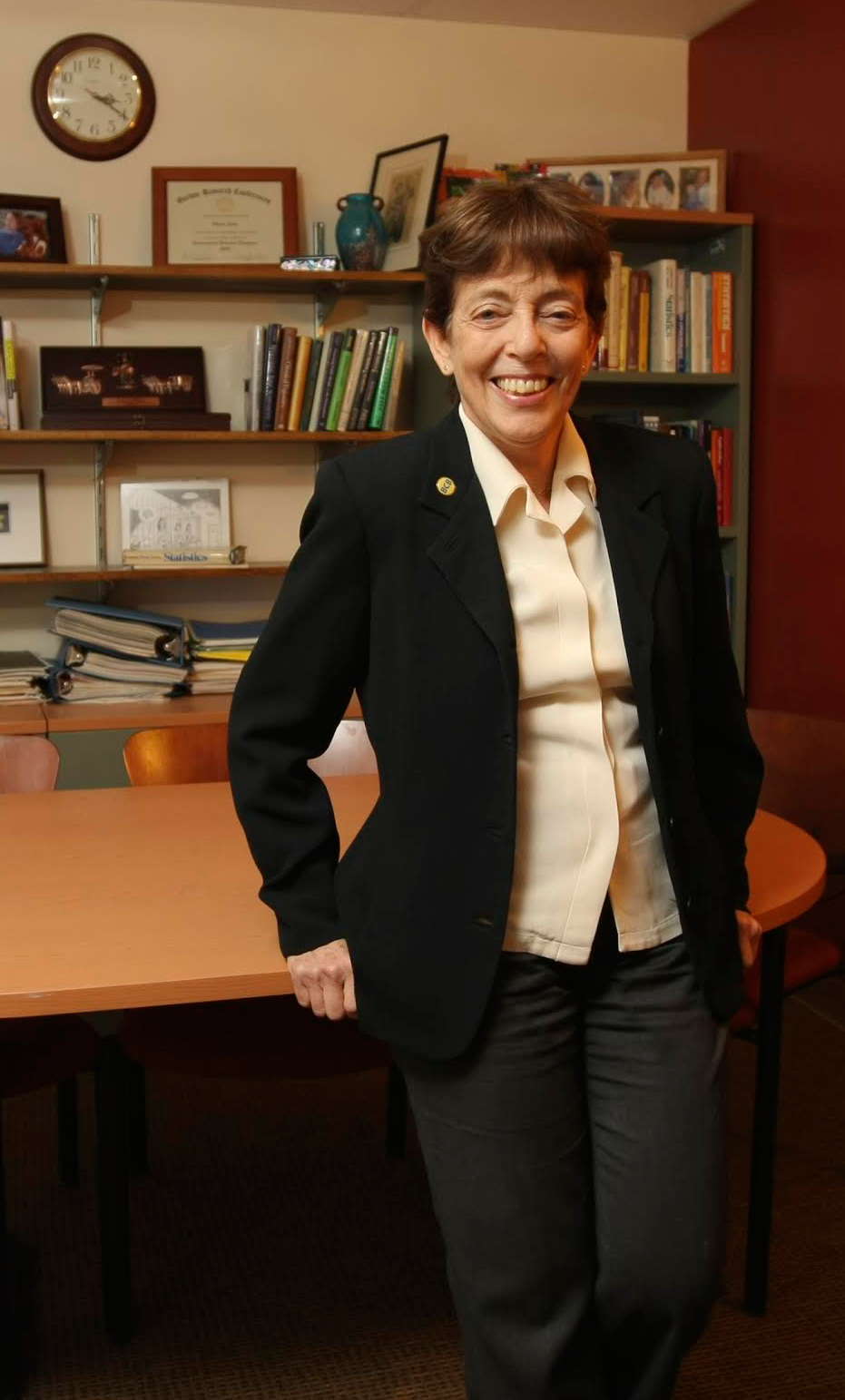
Dr. Shanna Swan is Professor of Preventive Medicine at the Icahn School of Medicine at Mount Sinai. (Photo: courtesy of Dr. Swan)
CURWOOD: Now, to what extent do you think your findings should influence public policy decisions to protect at-risk groups?
SWAN: Well, I think it should influence public policy. The last one did influence I think the move to remove phthalates from children's toys. This one I hope will help remove phthalates from food because that's how you'll protect the fetus because the fetus doesn't play with the plastic toys. So I think we need to go further back, we have to consider what the pregnant woman is exposed to, very early in pregnancy, and since she can't make those choices herself, she doesn't have the information, the only thing we can do is have the manufacturers keep the phthalates out and to do that probably government regulations will be the way to go.
CURWOOD: Dr. Shanna Swan is Professor of Preventive Medicine at Mount Sinai where her research focuses on the impact of environmental exposures on male and female reproductive health. Thank you so much for taking the time with us today.
SWAN: Thank you, Steve. Nice to talk.
Related links:
- Study: “First trimester phthalate exposure and anogenital distance in newborns”
- Information about phthalates from the National Institutes of Health (NIH)
- Center for Health, Environment, and Justice report on phthalates in children’s school supplies
Hormone Disruptors Linked to Genital Changes and Sexual Preference

Tyrone Hayes' at work in his lab in Berkeley (Photo: Ashley Ahearn)
CURWOOD: Well, the impacts of endocrine disruptors on sexuality and reproduction is a subject we’ve covered widely here at Living on Earth. A while back producer Ashley Ahearn reported how potentially disruptive contact with these hormone mimicking chemicals can be. Dr. Tyrone Hayes of UC Berkeley was investigating the effects of the endocrine disrupting pesticide Atrazine, which seems to affect the development of male frogs, causing them to become feminized, and to engage in homosexual behavior. Pediatric endocrinologist Stanley Rosenthal of UC San Francisco believes some of these same effects may be showing up in humans. Here’s part of Ashley’s report.
¬AHEARN: So, what about us? Could endocrine disruptors be having feminizing effects in humans? No one knows for sure, but some believe that rising rates of one birth defect could be an indicator.
[CAFETERIA SOUNDS, PIANO PLAYING IN THE BACKGROUND AT OAKLAND CHILDREN’S HOSPITAL]
AHEARN: Dr. Laurence Baskin is a pediatric urologist with the University of California, San Francisco but he practices here at the Oakland Children’s Hospital part of the time.
Today he’s performing back-to-back surgeries - and a very specific type of surgery. Baskin specializes in correcting hypospadias – the second most common birth defect in the country behind heart disease.
BASKIN: About one in 125 to one in 250 newborn males has an abnormality in their genitalia that could be described as hypospadias – and what I mean by that is penile curvature, abnormal urethra and an abnormal foreskin and putting that together that’s what hypospadias is defined as.
AHEARN: More babies are born with hypospadias than Down’s syndrome or cleft palate, and some research suggests that rates of hypospadias have increased in the past few decades. Baskin and others in his field suspect environmental exposures may contribute to hypospadias.
All fetuses are programmed to develop ovaries unless they’re told otherwise by certain hormones like testosterone and androgen.
Endocrine disrupting chemicals, like atrazine for example, could gum up the receptors for those hormonal messengers that tell a fetus to develop into a baby boy– or as Baskin explains – prevent the fetus from fully masculinizing.
BASKIN: The penis wouldn’t develop. It would be arrested meaning that your urethral opening would be lower down in the penile shaft, the penis normally as it develops is curved and it straightens out so in Hypospadias it wouldn’t have straightened out and the foreskin would only have formed on the top of the penis, wouldn’t have come down to the bottom because that lock or that hormone receptor would be blocked or disrupted by the environmental toxin.
AHEARN: Ok, so if Tyrone Hayes is finding feminizing effects in frogs who are exposed to Atrazine – one of these environmental toxins that Baskin is talking about – are there some parallels to be drawn in human beings? Baskin pauses for just a split second before responding.
BASKIN: Humans clearly are not frogs, but the theory is correct. And in this case we would agree with Dr. Hayes that an environmental disruptor, something in the environment, chemical toxin or medication could certainly be a risk factor for Hypospadias.
AHEARN: Baskin says the majority of hypospadias can be fixed with a relatively quick surgery that can make life a lot easier for the child later on.
BASKIN: I think growing up as a teenager and not having normal genitalia would be tough enough, even if you have normal genitalia, for regular emotional and sexual development so that’s really the major reason to fix it, so kids can be normal.
[CAFETERIA SOUNDS END, ELEVATOR DOOR, HALLWAY, PHONE RINGS]
AHEARN: But “normal” is a loaded term for some. Dr. Tiger Howard Devore is a sex therapist and clinical psychologist in New York City.
DEVORE: Isn’t it great that some doctor can tell you what’s normal? I love that.
AHEARN: For Devore, this is a personal story.
DEVORE: One of my earliest memories is of being in a hospital and dealing with some physician taking bandages off of my genitals and watching my parents respond in obvious fear about whatever it was that this guy was doing. I was probably maybe three. But I had my first surgery when I was three months old and I had at least one surgery every year after that until I was at least 12.
AHEARN: Devore was born with severe hypospadias. All told, he’s had 20 operations on his penis.
It wasn’t until college that Devore came to terms with his condition and decided to devote himself to helping others born with Hypospadias. As a psychologist, he says that if you follow Rosenthal and Baskin’s logic and look at hypospadias as incomplete masculinization of the genitals…
DEVORE:… the same thing probably happened in the brain in the areas where there’s sexual differentiation of the brain. Now it doesn’t make a person gay, lesbian, bisexual or transsexual but it certainly makes it easier for that person to be any of those things.
AHEARN: There’s no peer-reviewed scientific research to back up Devore’s claim about sexual orientation and hypospadias. However, the Hypospadias and Epispadias Association – a group, which works to raise awareness about these two similar genital conditions - conducted an online survey of roughly 700 men – with hypospadias and without. The survey found that men with hypospadias were 15 percent more likely to describe themselves as gay.
I told Devore about Tyrone Hayes – the biologist at Berkeley with the homosexual and feminized frogs – and asked him what he thought about those findings in relation to people. He said the connection makes sense…
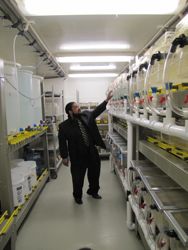
Tyrone Hayes' at work in his lab in Berkeley (Photo: Ashley Ahearn)
DEVORE: But we can’t prove it because we can’t experiment on human beings. We can certainly look at population models and say this looks like it’s pretty closely related, we probably should take some actions here to see if it is, but we can’t say that we don’t know the whole story yet.
AHEARN: Devore says there's a whole lot more to someone's sexual orientation than the chemicals they may have been exposed to during development.
DEVORE: This isn’t just about where you stick your things. This isn’t just about how you get good sensation in your body. This is about who you fall in love with. This is about a whole complex set of social factors.
CURWOOD: Clinical psychologist Dr. Tiger Howard Devore there, ending that excerpt from Ashley Ahearn’s report on the effects of endocrine disrupting chemicals on the development of males. There’s more on our website, LOE.org.
Related links:
- A study that looks at hypospadias and endocrine disruptors.
- Hypospadias and Epispadias Association
- Dr. Tiger Howard Devore
- Tyrone Hayes' research: Hermaphroditic, demasculinized frogs after exposure to the herbicide atrazine at low ecologically relevant doses
- Tyrone Hayes' research: Herbicides: Feminization of male frogs in the wild
[MUSIC: Cassandra Wilson, You Don’t Know What Love is. 1993 Blue Note]
CURWOOD: Human pressure on natural ecosystems is causing widespread extinction, but there may be some positive aspects as well...eventually. That's just ahead on Living on Earth. Stay tuned.
ANNOUNCER: Funding for Living on Earth comes from United Technologies, a provider to the aerospace and building systems industries worldwide. UTC Building & Industrial Systems, provides building technologies and supplies, container refrigeration systems that transport and preserve food, and medicine with brands such as Otis, Carrier, Chubb, Edwards and Kidde. This is PRI, Public Radio International.
[CUTAWAY MUSIC: Steve Reich Ensemble, Music for 18 Musicians 11 Section1. Nonesuch 2005]
Beyond the Headlines

EPA is considering a petition to make a seventeen-mile stretch of the Hackensack River into a massive Superfund site. (Photo: Anthony Quintano; Flickr CC BY 2.0)
CURWOOD: It's Living on Earth. I'm Steve Curwood. Off to Conyers, Georgia, now to catch up with Peter Dykstra. He’s with Environmental Health News, that’s EHN.org and the DailyClimate.org, and he’s been peering beyond the headlines at usual. Hi there, Peter.
DYKSTRA: Hi, Steve. You know, my thoughts are with you in the snowy northeast, have fun with all that snow while you can.
CURWOOD: Oh, well, we’ll try to anyway!
DYKSTRA: But let’s start with an item from my ancestral home, also in the northeast, northern New Jersey, specifically the banks of the Hackensack River, and the Jersey Meadowlands. Last year, they got some national recognition for being the Super Bowl site, and what could be better than that?
CURWOOD: Well, tell me.
DYKSTRA: How about being a Superfund site? There are several around the Meadowlands, but now EPA is considering a petition to make a 17-mile stretch of the Hackensack River into one big, long Superfund cleanup venue.
CURWOOD: Ah, a big dump. The locals must be so proud.
DYKSTRA: Well I wouldn’t say proud, but a couple of local mayors are welcoming the possibility of hosting the Superfund. The Meadowlands have been a dumping ground for New York City and New Jersey for 200 years – garbage, toxic waste drums, guys who couldn’t pay the loan shark fast enough – so it’s not like they’re unveiling some well-hidden pollution secret – but local officials say they’d appreciate a focused effort to clean up.
CURWOOD: I guess you can’t fix a problem unless you admit there is a problem.
DYKSTRA: Right. But one really cool thing about the Meadowlands; it’s withstood a 2 century long environmental beat down but the place is still alive. In decent weather, you can see kayakers out there, almost literally in the shadow of the Empire State Building, and it’s not a bad bird watching site, either. The resiliency of the Meadowlands, its potential recovery, and of course all that environmental abuse made it a perfect place for me to learn about the environment. The Meadowlands are in my blood, Steve.
CURWOOD: Maybe you’d better see a doctor about that one, Peter.

The Toxic Substances Control Act (TSCA) has been around for thirty-nine years, and both environmental safety advocates and the chemical industry say it’s in need of an update. The commercial weedkiller “Roundup” and its key ingredient Glyphosate are not currently covered by TSCA. (Photo: Mike Mozart; Flickr CC BY 2.0)
DYKSTRA: Boom! And speaking of untested chemicals…the Toxic Substances Control Act, better known as TSCA, is now 39 years old, and both environmental safety advocates and the chemical industry say it’s dangerously out of date.
CURWOOD: It seems to me that the reform of TSCA has been kicking around Congress for several years, right?
DYKSTRA: Right you are, Steve, Congress is on the case, and as you can imagine, the notorious gridlock of Congress is in full play when it comes to EPA regulating a major industry. Some want to strengthen TSCA, others want a weakened version that would override some of the very strong chemical safety laws passed by several states in recent years, but it’s all a moot point, because EPA acknowledges that it doesn’t have the resources to make the existing law work: about three-quarters of the 80,000 chemicals in use in the U.S. haven’t even been fully tested, let alone regulated. Elizabeth Grossman in the Guardian this past week wrote a great roundup on TSCA. Oh, and by the way, Roundup, the commercial weedkiller, and its key ingredient Glyphosate? - not covered by the Toxic Substances Control Act.
CURWOOD: Maybe we should regulate the bad puns, too. What have you got for us from the history vault?

Eighty-five years ago this week, Clyde Tombaugh discovered the planet Pluto, which in 2006 was demoted to “dwarf planet” status. However, the debate continues over whether Pluto is a planet. NASA’s New Horizons spacecraft, shown approaching Pluto in the above artist’s conception, will send pictures back to Earth later this year to try to settle the debate. (Photo: Kevin Gill; Flickr CC BY-SA 2.0)
DYKSTRA: Eighty-five years ago this week, Clyde Tombaugh discovered the planet Pluto.
CURWOOD: But wait, Pluto isn’t a planet anymore.
DYKSTRA: Bear with me here. Clyde Tombaugh was a Kansas farm-boy who had a fascination with astronomy. In 1928, at age 22, he built a telescope, grinding the lenses himself and building its mechanics from parts from a dairy machine and a 1910 Buick. He sent his observations to Arizona’s prestigious Lowell Observatory, hoping for a little feedback, and instead, they gave him a job and two years later, he found a new planet. An eleven year-old won a worldwide naming contest, it’s christened Pluto, 3.5 billion miles from the sun. But in 2006, using the vastly improved astronomical equipment – an international panel demotes Pluto to “dwarf planet” status.
CURWOOD: Could that be an example of planet denial?
DYKSTRA: Well, there are honorable men and women still arguing over Pluto’s status, and the debate is heating back up: NASA’s New Horizons spacecraft will wrap up a nine-year trip to Pluto this summer, and it’ll send back pictures.
CURWOOD: Thank you Peter. Peter Dykstra is with Environmental Health News, that's EHN.org and TheDailyClimate.org. Talk to you again soon.
DYKSTRA: All right, thanks again. Talk to you soon.
CURWOOD: And there's more on these stories on our website at LOE.org.
Related links:
- “Officials welcome Superfund possibility for Hackensack River”
- The Guardian: “Untested chemicals are everywhere, thanks to a 39-year-old US law. Will the Senate finally act?"
- Clyde Tombaugh: Astronomer Who Discovered Pluto
- New Horizons: NASA’s Mission to Pluto
- "Two planets as big as Earth ‘could be on edge of solar system"
[MUSIC: Aesop Rock, Bring Back Pluto. None Shall Pass, 2007, Block Chop Records]
Evolution in the Age of Mass Extinction
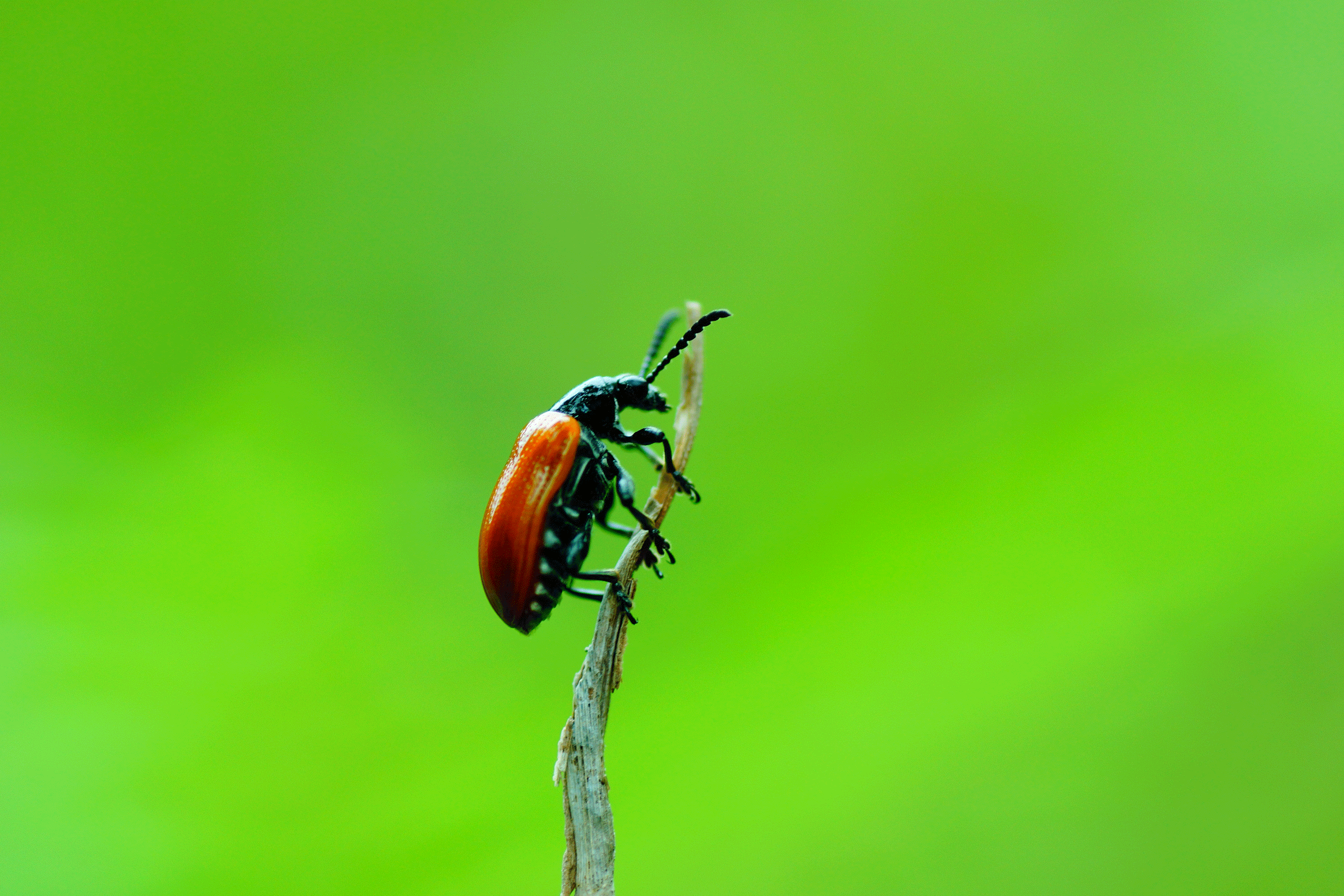
The Scarlet Lily Beetle is reviled by gardeners for eating lilies. But it’s a beautiful bug in its own right! (photo: Vengolis; CC 3.0)
CURWOOD: Many scientists believe that the Earth is undergoing mass extinction number six, this time not due to a random meteor but at the hands of humanity. But it’s not all gloom, according to Chris Thomas, an evolutionary biologist at York University in the UK. He sees some positive aspects in these grim circumstances, and Chris Thomas joined us on the line from England. Welcome to Living on Earth.
THOMAS: It's a pleasure to talk to you.
CURWOOD: What do you think of the idea that we're entering a major extinction period?
THOMAS: I think that's very likely. We're seeing unprecedented extinction rates at the moment, and the rates at which we're changing the planet's climate, altering the world's vegetation to produce our food, which obviously we need, polluting with nitrogen. So you see these effects all over the planet, and although they seem quite gradual in a way, if you sit back and think, "Well, humans have been around for a while, suppose they're around for another few hundred years to a few thousand years", just the rates of change you see at the moment are enough to cause a fairly major extinction event.
CURWOOD: But you put a silver lining on this black cloud.
THOMAS: Well, it's a slightly dull silver lining in the sense that a lot of this is going to take place long after we're buried and forgotten, I suspect. Well, what I see is that as we change the environment right across the world, this produces new opportunities for some of the species that exist now, and also provides new opportunities for new things to evolve that will be able to make use of the new environments that we're creating. So just as we see a mass extinction that appears to be emerging because of us, because of our activities, similarly we may see a huge sort of origination and explosion, if you like, of new ecosystems and new species that arise into the environments that we have changed.
CURWOOD: To what extent are we seeing this growth of biological diversity right now?
THOMAS: Surprisingly, a huge amount. But generally, we almost don't see it as that. We think, well, it's changed from how it was in the past, therefore it's bad, and therefore we see it almost as a loss even when it’s a gain in front of our eyes. So there are two kinds of process that are really giving rise to this. First is what I call ecological diversification, and the second is the evolutionary diversification.
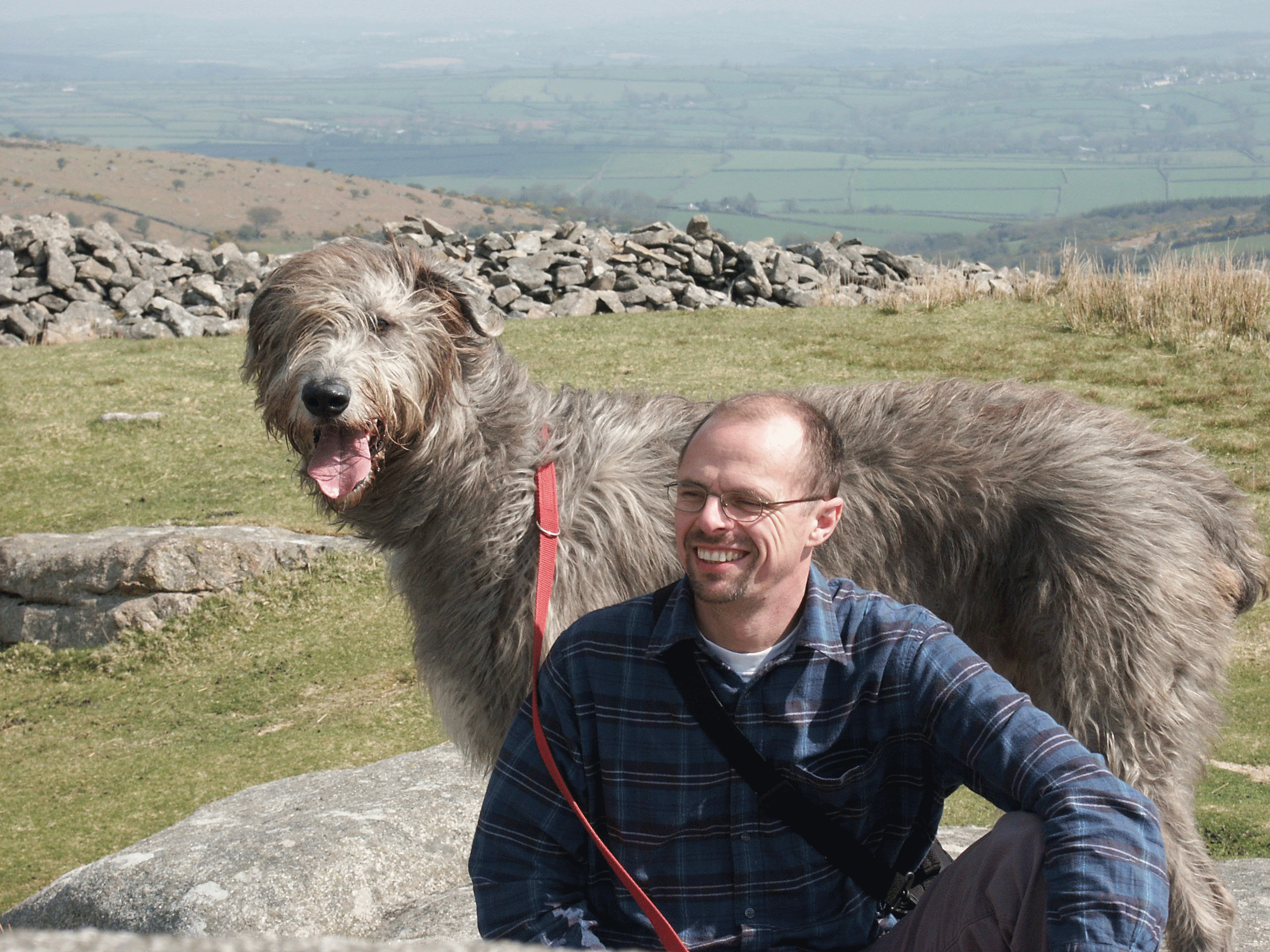
Chris Thomas and his dog Rex (Photo: Alice Thomas)
CURWOOD: Alright. Explain these to us. What do you mean by ecological diversification?
THOMAS: So ecological diversification. If you start off in an originally forested landscape, and you turn half of it into pastures, then you provide new ecological opportunities for species that like open habitats to live in that area. So although the diversity of the forest doesn't go up, it probably goes down a bit, the total diversity of the region can actually increase, because you've now got several types of habitat where you used to have just one. The other major effect that we're having is through introducing species to new parts of the world. In Britain, we've had between 1,500 and 2,000 species added to particularly on the plant side, but the animals and plant diversity of Britain is now higher than it used to be. Now the remarkable thing is that none of the native species have actually died out completely from Britain as a result of these new arrivals, so the whole diversity of the country is now much larger.
CURWOOD: So a bit of immigration leads to some more diversity, huh?
THOMAS: Yes, but it's not all positive. So if you introduce mammalian predators, rats and cats and things like that along with humans, to oceanic islands where all the species there have never met a mammalian predator before in their evolutionary history, these predators arrive and the native birds and so on simply don't know what to do with them, and they get driven to extinction very fast. So it isn't a universal thing, but on average, when you add a new species to a region, you tend to have a net increase in number of species because for every new species that you add, less than one of the existing species dies out.
CURWOOD: Let's talk about the evolutionary side of this. Talk to me about some of the new species, or some of the broader biological diversity that we're seeing right now.
THOMAS: Well, I can give you almost a little sort of mini-historical story where botanical collectors collected something, which subsequently became known as Oxford Ragwort. It was a plant, a yellow flower, a plant related to the daisies and to ragwort itself, which grew on Mount Vesuvius in Italy. And they brought it back and they cultured it in the botanical garden, and it took a very long time to gradually spread through the city of Oxford.
But eventually it did, and it likes growing in disturbed places so the city is quite a good place for it, and eventually it got to the railway station. Once it got to the railway station, all hell let loose because the seeds are very light. They can be blown in the wind. And they got caught in the vortices behind the trains, and they were moved from station to station because it likes stony ground and disturbed places. All the railway stations it turned up at were themselves ideal locations for this plant to grow, so it just spread around the country. And it was living in a habitat where there were no real native species living there, so it was just adding to the country's biodiversity without causing any damage.
But then what happened was it in a few places it ended up hybridizing with groundsel which is sort of a distantly-related species but they can hybridize, and at least three of these hybrids ended up becoming sufficiently genetically distinct that you can now think of them as species in their own right. So we've now got four new ragwort-groundsel species and they've added to British diversity and in fact through these hybridizations they've added to world diversity.
CURWOOD: You've talked about flora, what about fauna, what about animals that are changing right in front of our eyes?

The Tuatara is one of the most genetically distinct species on earth. Chris Thomas thinks that species like this should be of top priority when it comes to saving (Photo: Knutschie; public domain)
THOMAS: Yes, so there's a couple of native plant feeding insects in North America, which it turned out hybridized. Now, these hybrids were able to live on introduced and so-called invasive European honeysuckles. So this species has now spread and so we've added one more species of insect to the world, and it's feeding on a plant that people thought was a bit troublesome. And so it's probably rather a good thing. Of course, sometimes, when we introduce plants, the insects arrive and then people don't like them. We've got a beautiful lily beetle which I believe has colonized North America as well as northern Europe that feeds on garden lilies and to me as an insect ecologist it’s an absolutely beautiful insect, this orangey color, but it does rather devastate your prize lilies, and so gardeners are very upset about this. But they're just species. So, I'm not really saying any of this is good or bad, what I'm observing is that if we look across the planet both through the ecological processes of insects following the plants that they eat on, hybridization, species just evolving when new opportunities arise that they can exploit, that what we're starting to see is this emergence of a new diversity which is rather strongly associated with human activities.
CURWOOD: So, what's your take on then on the whole concept of invasive species, and the fear that people tend to have around them? I'm wondering if you see this as perhaps just a fear of change, a desire to just keep things the way they are when maybe in your view nature doesn't work that way?
THOMAS: Well, in the long run, nature absolutely does not work in that way. I know most people think that 21,000 years ago is rather a long time ago, but in terms of the history of life on Earth, it's not even yesterday. You can imagine yourself back to 21,000 years ago in the middle of the last ice age, almost none of the species that you would see where you are right now would be the same. The whole of the new vegetation where all the animals are now is new compared to what it was just 21,000 years ago. And so if you start thinking about invasive species, well, everything is an invasion on this time scale.
CURWOOD: Professor, what do you think of what we're seeing around the world in terms of these dramatic and sometimes heroic efforts to save particular species of plants and animals. In the context of climate disruption, people are pointing to a lot of plants and animals that are going to go away and kind of quickly. Should we attempt to save as much as we can, or essentially roll with it?
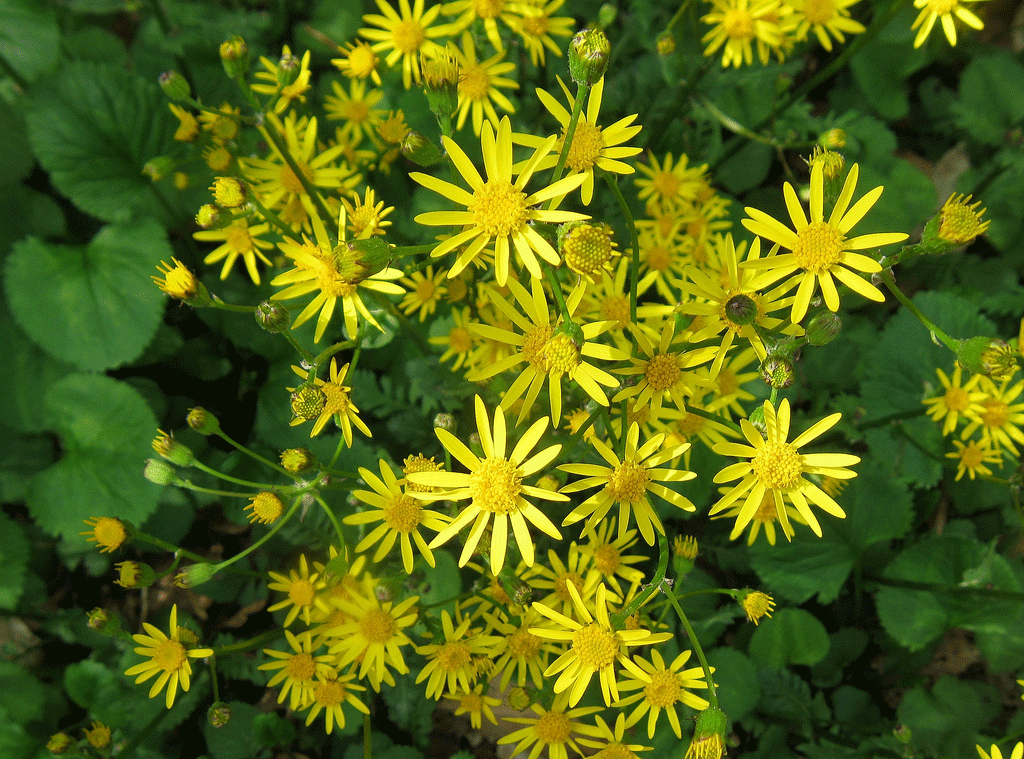
Common groundsel (pictured above) has hybridized with Vesuvius Ragwort to create a new species in Britain (Photo: Pauline Rosenberg; CC 2.0)
THOMAS: Environmental change is absolutely inevitable. It's been going on steadily for the last century, in fact, it's been going on for much longer than that, and I think what we should be thinking about in an environmental context is how we live with that change rather than our starting point simply and always be to try and keep things exactly as they are or go back to some imagined past type of ecosystem. It isn't going to be done. We're going to lose if that is our approach.
If we try to keep things the way they were, then for example, as the climate changes, helping species move to new areas where they may be able to thrive in the future would be off the agenda, because that would be making things less like the past. But it may still be saving species. And these more flexible approaches are maximizing opportunities as well as minimizing harms. I would think that's the way to go.
CURWOOD: Some people listening to you might say that you're saying, hey, everything's going to be OK. We could keep on going because nature's going to evolve and adapt and we shouldn't worry. To what extent are you concerned that people are going to take your message as license to keep on polluting, just keep on consuming?
THOMAS: That's not what I feel. I think if we end up wiping out, say, a quarter of the species, maybe slightly more, I think from an individual personal perspective that's a tragedy. I think from some sort of a utilitarian perspective, it's one hell of a waste of biological material that might have been of use to humanity at some point in the future, so I think it's a kind of madness, I think it's a shame.
What I'm really saying is that as we're living through what appears to be mass extinction caused by us, it's also extremely interesting to see just the beginnings of the shoots of recovery. It's not necessarily all rosy whatsoever, but it is a very interesting evolutionary and ecological phenomenon that as we modify and transform the planet in a enormous number of ways, the biological diversity is ready to give it a go of seeing what it can do with these new conditions.
CURWOOD: Chris Thomas is a Professor of Conservation Biologist at University of York in the UK. Thanks so much, Professor, for joining us.
THOMAS: You're very welcome.
Related link:
Chris Thomas teaches biology at the University of York
[MUSIC: DJ Krush, Jaku. Music from Little Big Planet. 1969, Vanguard]
Learning to Climb
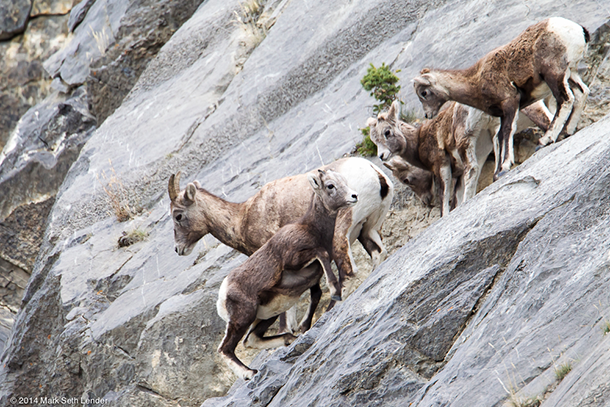
The ewe leads them to the edge, but will not show them how to climb down. (Photo: Mark Seth Lender)
CURWOOD: Rocky Mountain big horn sheep are born with all the climbing gear they need: feet evolved to grab and hold on near-vertical rock, and an uncanny sense of balance. Writer Mark Seth Lender came across a herd of the sheep near Alberta’s Jasper National Park late last summer and discovered that for the lambs, having the equipment is not enough. They still have to learn how to use it.
Leap of Faith: Lambs Learn to Climb
Rocky Mountain Big Horn Sheep, Jasper National Park, Canada
© 2014 Mark Seth Lender
All Rights Reserved
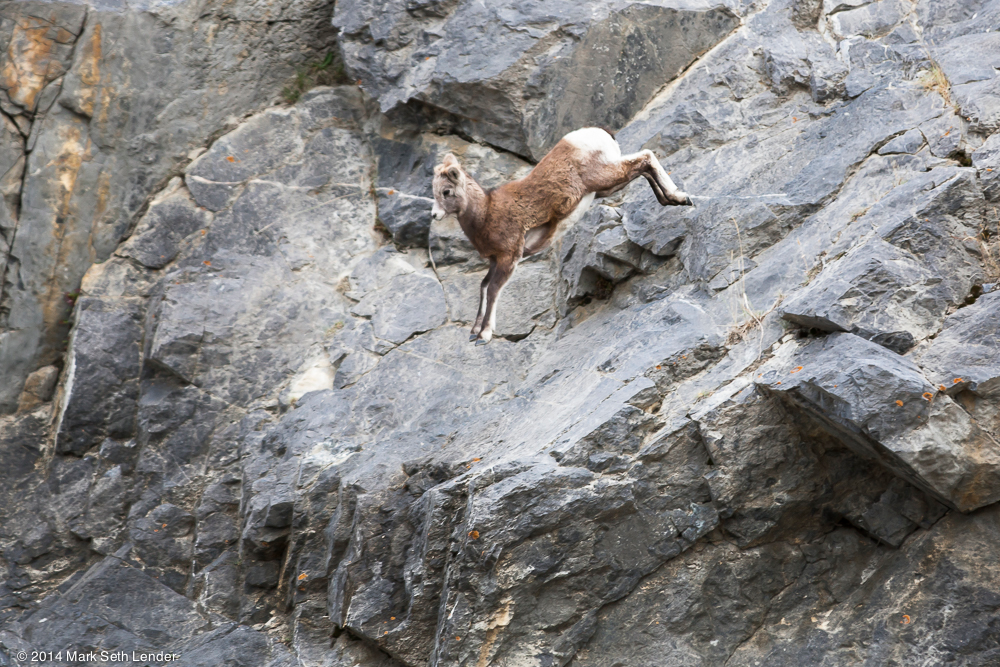
Bighorn lambs learn to climb and, like you, they can fall a thousand feet just once. (Photo: Mark Seth Lender)
LENDER: They are working it out. The lambs, by themselves. Where the mountain tapers smooth and hard off the ridgeline. The rest of the herd, already picking their way among the crags and cracks is heading down. But the lambs upon this unfamiliar terrain, hold back. The ewe by her stance and where she looks has led them here. To the edge. But will not show them how. Down they will learn on their own.
She stands aside, and waits.
They will not amble like the lambs of the ground. They are not full of play. They stand on the high point and look, long, toward the river and the sweet grass far… far… below. They look. And look: To left to right slowly turning their heads. They plan: each move, each angle polished into an extended curve. A calculus: For every waypoint, every stopping place, the risk of a dead end.
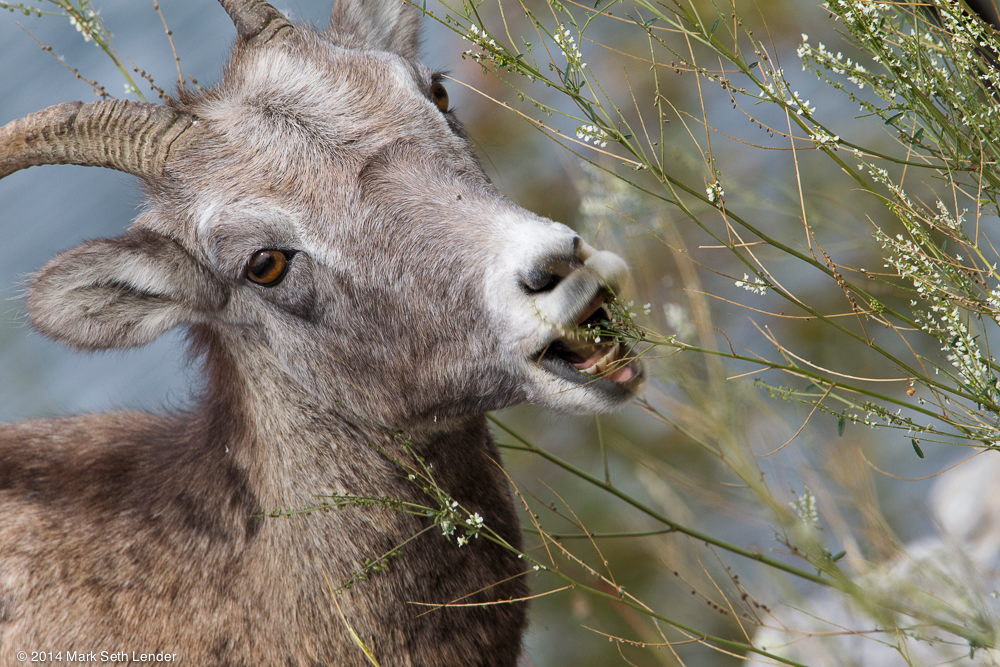
A Rocky Mountain bighorn ewe feeds. (Photo: Mark Seth Lender)
Nor is the route straightforward.
Sometimes the only down is up: they scramble against the vertical, grappling with their cloven feet, the ledge where the gamble led too narrow for a bird.
Sometimes, what looks easy is impossible: the gradual slope, which ends in a sheer and impassible cliff.
Sometimes the granite cleaved along the head grain is the only path and the only safety a headlong run, the living rock inclined too steep for caution.
The hooves of rocky mountain big horn sheep are broad as a puck, gray as the living rock (as if the color gives them grip). They hold, like India rubber pads, where purchase seems untenable, a magician’s trick, inertia where there should be none. Up where the trees are far and few and the dead wood outnumbers the living...

A ram, already made his way down the cliff, drinks. (Photo: Mark Seth Lender)
The herd, already arrived, goes about its grazing.
The rams lick salt by the side of the road.
At the river others drink.
Not a one looks up to see who will be…one of them.
And the Rocky Mountain Big Horn babies look down and down and down, their ears, raised, the hairs standing straight out. Like you they can fall 1,000 feet, just once.
CURWOOD: Writer Mark Seth Lender. There are pictures at our website, LOE.org.
Special thanks to Fraserway RV and Judy Love Rondeau.

A bighorn lamb takes a leap of faith. (Photo: Mark Seth Lender)
Related links:
- Sun Dog Tours in Alberta's Jasper National Park
- Travel Alberta
- Fraserway RV Rentals
[MUSIC: John Fahey, The Essential John Fahey, The Yellow Princess. 1974, Vanguard]
Living on Earth is produced by the World Media Foundation. Our crew includes Naomi Arenberg, Bobby Bascomb, Emmett Fitzgerald, Lauren Hinkel, Helen Palmer, Adelaide Chen, Jenni Doering, John Duff, James Curwood, and Jennifer Marquis. Our show was engineered by Tom Tiger, with help from Jake Rego and Noel Flatt. Alison Lirish Dean composed our themes. You can find us anytime at LOE.org - and like us, please, on our Facebook page - it’s PRI’s Living on Earth. And we tweet from @LivingOnEarth. I'm Steve Curwood. Thanks for listening.
ANNOUNCER1: Funding for Living On Earth comes from the Grantham Foundation for the protection of the environment, supporting strategic communication and collaboration in solving the world’s most pressing environmental problems. The Kendeda Fund, furthering the values that contribute to a healthy planet, and Gilman Ordway for coverage of conservation and environmental change. Living on Earth is also supported by Stonyfield Farm, makers of organic yogurt, smoothies and more; www.stonyfield.com.
ANNOUNCER2: PRI. Public Radio International
Living on Earth wants to hear from you!
Living on Earth
62 Calef Highway, Suite 212
Lee, NH 03861
Telephone: 617-287-4121
E-mail: comments@loe.org
Newsletter [Click here]
Donate to Living on Earth!
Living on Earth is an independent media program and relies entirely on contributions from listeners and institutions supporting public service. Please donate now to preserve an independent environmental voice.
NewsletterLiving on Earth offers a weekly delivery of the show's rundown to your mailbox. Sign up for our newsletter today!
 Sailors For The Sea: Be the change you want to sea.
Sailors For The Sea: Be the change you want to sea.
 The Grantham Foundation for the Protection of the Environment: Committed to protecting and improving the health of the global environment.
The Grantham Foundation for the Protection of the Environment: Committed to protecting and improving the health of the global environment.
 Contribute to Living on Earth and receive, as our gift to you, an archival print of one of Mark Seth Lender's extraordinary wildlife photographs. Follow the link to see Mark's current collection of photographs.
Contribute to Living on Earth and receive, as our gift to you, an archival print of one of Mark Seth Lender's extraordinary wildlife photographs. Follow the link to see Mark's current collection of photographs.
 Buy a signed copy of Mark Seth Lender's book Smeagull the Seagull & support Living on Earth
Buy a signed copy of Mark Seth Lender's book Smeagull the Seagull & support Living on Earth

